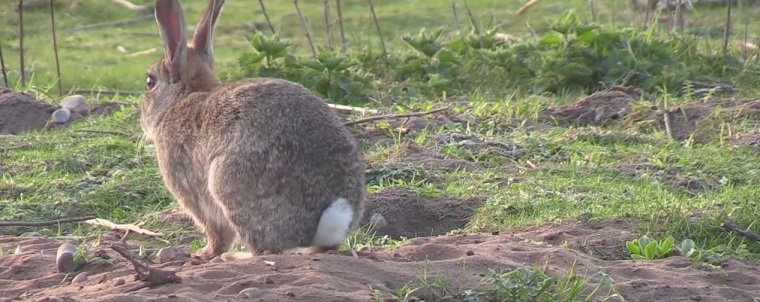-
info@aaanimalcontrol.com
Call us for help in your town
Humane Wildlife Education
What kind of damage can Rabbits cause?
Need rabbit removal in your hometown? We service over 500 USA locations! Click here to hire us in your town and check prices - updated for year 2020.
A farmer can lose one percent of their annual winter wheat yield from just ONE grazing rabbit alone, per hectare? Depending on the species of rabbit, many of them can live in a single area, so the more rabbits you have, the higher the percentage the farmer will lose of their crops. If there were just five bunnies on that one hectare of winter wheat, that would be five percent of the entire annual crop destroyed.

Now multiply that many times over. And then again. And then once more for good luck. That's what happens when you let a wild rabbit invasion take over your land. They’re cute and fluffy animals for sure, but the damage they can do — just one rabbit can do — is incredible. And, usually rather expensive to repair.
Not just wheat that is affected, other crops will regularly come under attack from rabbit attackers, including oats and barley. That's before we get into residential areas too — if you have a flower bed, lawn, patch of wild flowers, or vegetables/fruits growing, you are at risk of coming under attack too.
As well as the utter destruction to plant life, usually crops and food sources for humans, rabbits also have the potential to cause hundreds, thousands, and, in the worst cases, millions of dollars worth of damage to structures. They burrow beneath the ground, which can seriously disrupt the stability of roads, buildings, railways, and others. Just a small amount of burrow underneath a shed, for example, would be enough to cause the ground to collapse. Again, just like with crop damage, the more rabbits you have, the bigger and more costly the problem will end up being.
As well as munching through crops, and digging below roads, rabbits can also uproot new plants and bulbs, scratching up flower beds like they're a personal playground.
Alongside this physical damage, rabbits can spread disease quicker than many other animals combined. The UK is a classic example of how rabbit populations can easily get out of control, and how quickly rabbits can adapt to better survive. It has been estimated that in the last decade alone, over 60 million wild rabbits in the UK are now disease-resistant, meaning that they can carry the diseases, and even pass them on, but they won't be killed by them. Disease is a big factor behind keeping wild animal populations down, so the fact that UK rabbits are becoming resistant to diseases is not a good thing. And that's not all, the UK population of rabbits have also evolved and adapted in another way — breeding. It is becoming more and more ‘the norm’ for rabbits to reproduce all throughout the year, rather than just in certain seasons.
The story this side of the water isn’t any happier, sadly. As well as wild rabbits that are native to the area, there are now newly-introduced species of the animal. This is the case in Washington, where Nuttall’s cottontail and the Pygmy rabbit were the original native species. They have since been joined by the ‘domestic rabbit’ and the Eastern cottontail, which wasn’t originally found in the area. Many of these non-native rabbit species were introduced by negligent pet owners who purchased the animal and then realized the upkeep and maintenance that would be necessary to take care of them, releasing them into the wild. They then breed, with each other — other released pet species — and also with other species, causing hybrids. This is another problem you have when there is a big rabbit problem — different species will breed with each other, pets with wild and vice versa, and that creates species that are disease-resistant and breed more frequently, as is the problem in the United Kingdom.
Read about How to Get Rid of Rabbits.
For more information, you may want to click on one of these guides that I wrote:
How To Guide: Who should I hire? - What questions to ask, to look for, who NOT to hire.
How To Guide: do it yourself! - Advice on saving money by doing wildlife removal yourself.
Guide: How much does wildlife removal cost? - Analysis of wildlife control prices.


















